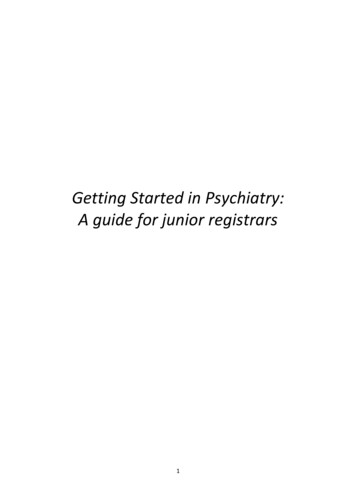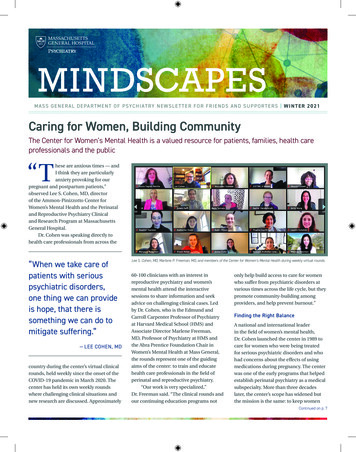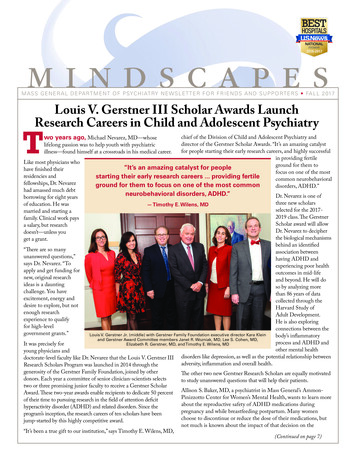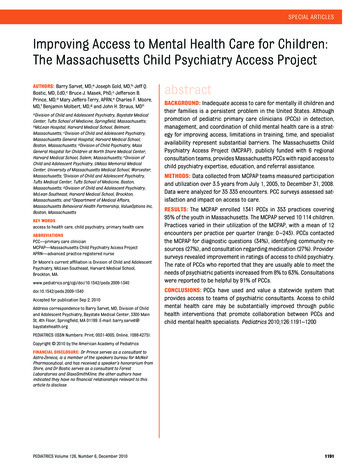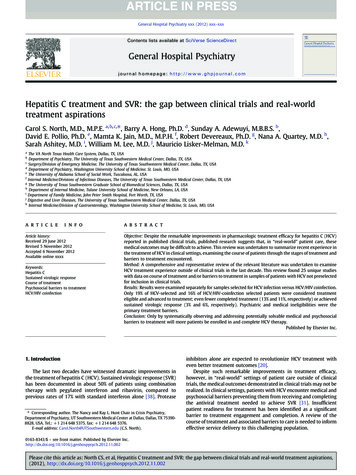
Transcription
General Hospital Psychiatry xxx (2012) xxx–xxxContents lists available at SciVerse ScienceDirectGeneral Hospital Psychiatryjournal homepage: http://www.ghpjournal.comHepatitis C treatment and SVR: the gap between clinical trials and real-worldtreatment aspirationsCarol S. North, M.D., M.P.E. a, b, c,⁎, Barry A. Hong, Ph.D. d, Sunday A. Adewuyi, M.B.B.S. b,David E. Pollio, Ph.D. e, Mamta K. Jain, M.D., M.P.H. f, Robert Devereaux, Ph.D. g, Nana A. Quartey, M.D. h,Sarah Ashitey, M.D. i, William M. Lee, M.D. j, Mauricio Lisker-Melman, M.D. kaThe VA North Texas Health Care System, Dallas, TX, USADepartment of Psychiatry, The University of Texas Southwestern Medical Center, Dallas, TX, USAcSurgery/Division of Emergency Medicine, The University of Texas Southwestern Medical Center, Dallas, TX, USAdDepartment of Psychiatry, Washington University School of Medicine, St. Louis, MO, USAeThe University of Alabama School of Social Work, Tuscaloosa, AL, USAfInternal Medicine/Divisions of Infectious Diseases, The University of Texas Southwestern Medical Center, Dallas, TX, USAgThe University of Texas Southwestern Graduate School of Biomedical Sciences, Dallas, TX, USAhDepartment of Internal Medicine, Tulane University School of Medicine, New Orleans, LA, USAiDepartment of Family Medicine, John Peter Smith Hospital, Fort Worth, TX, USAjDigestive and Liver Diseases, The University of Texas Southwestern Medical Center, Dallas, TX, USAkInternal Medicine/Division of Gastroenterology, Washington University School of Medicine, St. Louis, MO, USAba r t i c l ei n f oArticle history:Received 29 June 2012Revised 5 November 2012Accepted 6 November 2012Available online xxxxKeywords:Hepatitis CSustained virologic responseCourse of treatmentPsychosocial barriers to treatmentHCV/HIV coinfectiona b s t r a c tObjective: Despite the remarkable improvements in pharmacologic treatment efficacy for hepatitis C (HCV)reported in published clinical trials, published research suggests that, in “real-world” patient care, thesemedical outcomes may be difficult to achieve. This review was undertaken to summarize recent experience inthe treatment of HCV in clinical settings, examining the course of patients through the stages of treatment andbarriers to treatment encountered.Method: A comprehensive and representative review of the relevant literature was undertaken to examineHCV treatment experience outside of clinical trials in the last decade. This review found 25 unique studieswith data on course of treatment and/or barriers to treatment in samples of patients with HCV not preselectedfor inclusion in clinical trials.Results: Results were examined separately for samples selected for HCV infection versus HCV/HIV coinfection.Only 19% of HCV-selected and 16% of HCV/HIV-coinfection selected patients were considered treatmenteligible and advanced to treatment; even fewer completed treatment (13% and 11%, respectively) or achievedsustained virologic response (3% and 6%, respectively). Psychiatric and medical ineligibilities were theprimary treatment barriers.Conclusion: Only by systematically observing and addressing potentially solvable medical and psychosocialbarriers to treatment will more patients be enrolled in and complete HCV therapy.Published by Elsevier Inc.1. IntroductionThe last two decades have witnessed dramatic improvements inthe treatment of hepatitis C (HCV). Sustained virologic response (SVR)has been documented in about 50% of patients using combinationtherapy with pegylated interferon and ribavirin, compared toprevious rates of 17% with standard interferon alone [38]. Protease⁎ Corresponding author. The Nancy and Ray L. Hunt Chair in Crisis Psychiatry,Department of Psychiatry, UT Southwestern Medical Center at Dallas, Dallas, TX 753908828, USA. Tel.: 1 214 648 5375. fax: 1 214 648 5376.E-mail address: Carol.North@UTSouthwestern.edu (C.S. North).inhibitors alone are expected to revolutionize HCV treatment witheven better treatment outcomes [20].Despite such remarkable improvements in treatment efficacy,however, in “real-world” settings of patient care outside of clinicaltrials, the medical outcomes demonstrated in clinical trials may not berealized. In clinical settings, patients with HCV encounter medical andpsychosocial barriers preventing them from receiving and completingthe antiviral treatment needed to achieve SVR [31]. Insufficientpatient readiness for treatment has been identified as a significantbarrier to treatment engagement and completion. A review of thecourse of treatment and associated barriers to care is needed to informeffective service delivery to this challenging population.0163-8343/ – see front matter. Published by Elsevier 11.002Please cite this article as: North CS, et al, Hepatitis C treatment and SVR: the gap between clinical trials and real-world treatment aspirations,(2012), 02
2C.S. North et al. / General Hospital Psychiatry xxx (2012) xxx–xxxTable 1Articles included in the review and summary of methods in the studies representedHCV samples (17 studies)Authors/yearSampleNData collection methodBini et al., 2005 [3]Convenience sample of patients with HCV from24 VA medical centers4048Butt et al., 2005 [5]Military veterans with HCV referred to a GI/hepatology specialty clinicPatients with HCV referred to a VA HCV clinicPatients with HCV in a community liver clinic354Systematic interviews of patients and interviews oftheir treating clinicians about their opinions of thesepatients' suitability for treatment (compared withstandardized criteria for treatment eligibility)Prospective data from medical record reviewConvenience sample of intravenous drug userswith HCV from primary health or methadoneclinics in SydneyPatients with HCV at teaching county hospitalliver clinicConvenience sample of patients with HCV fromtwo inner-city multidisciplinary communityclinics in CanadaMilitary veterans with HCVDrug users with HCV from addiction clinicsConvenience sample of patients with HCV fromvarious healthcare clinics (5 large hospitals, needleexchange sites, Hepatitis Council of Victoria andcommunity health centers) and nonclinical sites(news media) in the state of Victoria, AustraliaIntravenous drug users with HCV treated at JohnsHopkins Hospital clinicsPatients with HCV from an outpatient liver clinicPatients with HCV in a community health center100Chart reviewRetrospective chart review clinical assessmentsby patients’ treating hepatologistInterviewer-administered surveys293Medical record review188Self-administered questionnaires520196224Medical record reviewProspective cohort studyProspectively administered 78-item patientquestionnaire597Longitudinal cohort study using prospectiveadministration of a patient questionnaireRetrospective medical record reviewElectronic medical record review and individualinterviews with patients’ primary care providersAssessment for treatment eligibilityCawthorne et al., 2002 [9]Delwaide et al., 2005 [10]Doab et al., 2005 [11]Falck-Ytter et al., 2002 [12]Grebely et al., 2008[16]Groom et al., 2008 [17]Lindenburg et al., 2011 [19]McNally et al., 2006 [22]Mehta et al., 2008 [23]Moirand et al., 2007 [25]Morrill et al., 2005 [26]Muir et al., 2002 [27]Rowan et al., 2004 [30]Seal et al., 2007 [32]Zickmund et al., 2004 [39]5572991317208Consecutive sample of patients with HCV atDurham VA Medical CenterConsecutive sample of patients with HCV fromHouston Veterans Affairs Medical Center HCV clinic100Patients with untreated HCV from gastroenterology,hepatitis and infectious disease clinics at24 VA medical centers who were followedthrough treatmentPatients with chronic HCV selected from hepatologyclinics, with 80% full participation4318580322Information was gathered prospectively ondemographics, medical history, current medicalcondition, psychiatric history and psychiatric statusProspective study of completed questionnairesand assessmentsCross-sectional semistructured interviewsCoinfected (HCV HIV) samples (8 studies)Authors/yearSampleCacoub et al., 2006 [8]HIV/HCV-coinfected patients of 71 physicians fromspecialized treatment centers in metropolitanFranceHIV/HCV-coinfected patients from Boston MedicalCenter coinfection clinicHIV/HCV-coinfected patients from Hepatitis &AIDS Liver Outcome (HALO) study at BostonMedical CenterHIV/HCV-coinfected patients from REACH programin San Francisco (64% participation)HCV/HIV-coinfected patients at Ottawa HospitalViral Hepatitis ClinicHCV/HIV-coinfected patients presenting to a HCVprogram at a HIV clinicVolunteer sample of treatment-eligible HIV/HCVcoinfected patients recruited from HIV clinics(84% had complete data)HIV/HCV-coinfected patients in free lunchprograms, homeless shelters and single roomoccupancy hotels in San Francisco REACH program(86% participation) and their 52 primary careproviders (84% participation)Fleming et al., 2003 [13]Fleming et al., 2005 [14]Hall et al., 2004 [18]McLaren et al., 2008 [21]Murray et al., 2011 [28]Nunes et al., 2006 [29]Thompson et al., 2005 [37]1.1. The Andersen health services model for review of barriers to carefor HCVThe Andersen [2] model of health services provides a conceptualframework to organize the review of barriers to HCV treatment [24].NData collection method380Physician surveys regarding their patients180Prospective study through questionnaires, physicalexaminations and medical record reviewProspective study through questionnaires, physicalexaminations and medical record review94182102Prospective study using questionnaires and baselinelaboratory assessmentsRetrospective medical record review134Retrospective medical record review168Interviews of patients and primary care providers andmedical record review133Quarterly structured interviews for patients andsemistructured interviews for providersThis model facilitates the identification of modifiable patient andhealthcare system factors that may lead to improved coordination ofcare and related health outcomes [15]. Thematic categories in theAndersen model are individual/patient factors (need, enabling andpredisposing factors), health service system factors (insurancePlease cite this article as: North CS, et al, Hepatitis C treatment and SVR: the gap between clinical trials and real-world treatment aspirations,(2012), 02
C.S. North et al. / General Hospital Psychiatry xxx (2012) xxx–xxx3Table 2Patients’ flow through treatment stagesHCV samples (15 studies)1st author/yearBini, 2005Butt, 2005Cawthorne, 2002Delwaide, 2005Falck-Ytter, 2002Grebely, 2008Groom, 2008Lindenburg, 2010McNally, 2006Mehta, 2008Moirand, 2007Morrill 2005Muir, 2002Rowan, 2004Seal, 2007SampleEligibleStarted treatmentCompleted �–3Coinfected (HCV/HIV) samples (8 studies)1st author/yearCacoub, 2006Fleming, 2005Fleming, 2003Hall, 2004McLaren, 2008Murray, 2011Nunes, 2006Thompson, 2005SampleEligibleStarted treatmentCompleted 243–212––2380274149182102134168133systems, qualified treatment force, fragmented specialty care, medicaltherapeutics) and treatment-related factors (accessibility of care,availability of service, support, affordability of care and knowledge).Modifiable factors in these categories contain items that can betargeted for interventions to improve health outcomes.2. Methods2.1. Selection of research articles and organization of the findingsA comprehensive and representative review of the literature onthe course of HCV treatment in clinical care settings was undertakento examine HCV treatment experience outside of clinical trials in thelast decade. Articles from the last decade describing the course oftreatment in HCV patient care settings were sought to investigatehow patients engage in and complete HCV treatment, and thebarriers to care they may experience during their journey topotential treatment. This analysis integrates data from the literatureon the course of HCV treatment, medical outcomes and barriers tocare in populations of HCV patients presenting for health care.Findings from this review were generally organized based on theAndersen model categories.This review was designed to investigate experience in the courseof HCV treatment in real-world care settings in a representative coregroup of articles with original data related to the course of treatmentand barriers to treatment of HCV encountered in samples of largelyunselected patients presenting to clinical care settings. This reviewwas not intended to include the entire collection of numerous studiesutilizing selected, circumscribed samples such as patients referred forrandomized controlled pharmaceutical trials and studies of patientsalready selected for treatment eligibility or to be exhaustive of allpublished studies of HCV.For this review, a PubMed search on the phrase “course of hepatitisC treatment” yielded 2024 articles. These articles were considered,%272–1835–171–1826–1along with all the relevant studies found in references in them, forinclusion in this review. Because most articles in the searchrepresented randomized controlled trials or were confined to patientsamples previously selected for treatment, they were not included. Theremaining studies provided data on the course of patient flow throughHCV treatment and/or barriers to care in this progression in nonclinical-trial patient samples and were thus included in this review.This process yielded a total of 26 articles; one [7], however, had asample that substantially overlapped with that of an earlier article bythe same research group [8]. Exclusion of that article resulted in a totalof 25 unique studies (17 for HCV-selected samples and 8 for HCV/HIVcoinfected samples) with nonoverlapping original data (Table 1). Twoof these 25 articles [11,39] did not provide summary data on patientflow through the basic treatment progress stages, but includedinformative detail on categories of barriers to treatment (Table 2).Thus, 23 of the 25 articles reviewed here (15 for HCV-selected samplesand 8 for HCV/HIV-coinfected samples) provided summary data on thestages of patient progress through treatment (see below). This reviewprovides results separately for studies of non-clinical-trial samples ofpatients with HCV and those with HCV/HIV coinfection based onpreexisting evidence of differences between these two groups inbarriers to treatment and course of treatment [1].2.2. Patient flow through stages of treatmentFor each study reviewed, patient flow data were recorded as theproportions proceeding through five basic stages of treatmentprogression: (a) presenting for clinical care (i.e., inclusion in thesample, 100% by definition), (b) treatment eligibility, (c) startingtreatment, (d) completing treatment and (e) attainment of SVR. Twoindependent abstracters examined articles included in this reviewand recorded statistics presented in each of the specified categories.Because the presentation of findings was not systematic among thestudies included in this review, ambiguities in designation ofPlease cite this article as: North CS, et al, Hepatitis C treatment and SVR: the gap between clinical trials and real-world treatment aspirations,(2012), 02
4C.S. North et al. / General Hospital Psychiatry xxx (2012) xxx–xxxFig. 1. Diagram of patient flow through treatment stages (HCV-selected samples).assignment to these categories were resolved by team consensus bythe members of this research team whose expertise includesinfectious disease, hepatology, psychiatry and social work.tables; general observations about the representation of these barriersin real-world HCV treatment in these studies are provided in text.2.4. Statistical analysis2.3. Categories of barriers to careCategories of barriers to treatment, informed by the Andersonmodel, identified in these articles were medical ineligibility, patientrelated barriers, provider-related barriers and medical care systemsbarriers. Barriers reported in these studies were tabulated for eachcategory of barrier for each study reviewed. Different articles groupedand reported their findings for the types of barriers in different waysand often included overlapping numbers in more than one category.Because these categories were variably represented in these studies,and often in small numbers, it is not possible to systematicallysummarize the proportions of patients encountering these barriers inSummary statistics were developed with numbers and proportionscompleting each of the five stages of the patients’ progress throughtreatment. Proportions were calculated as the total number ofpatients completing a stage divided by the combined number ofpatients represented in the studies reporting numbers on that stage.These statistics were recalculated separately for only the studies thathad complete data for all five stages; Figs. 1 (HCV-selected samples)and 2 (HCV/HIV-coinfection samples) illustrate the results of bothof these calculations of proportions at each stage of treatmentprogress superimposed upon one another in the same figures fordirect comparison.Fig. 2. Diagram of patient flow through treatment stages (HCV/HIV-coinfection selected samples).Please cite this article as: North CS, et al, Hepatitis C treatment and SVR: the gap between clinical trials and real-world treatment aspirations,(2012), 02
C.S. North et al. / General Hospital Psychiatry xxx (2012) xxx–xxx3. ResultsStudies in this review included samples from a variety of treatmentsubpopulations, including military veterans, injection drug users andHCV-infected patients with other risk factors. The original dataobtained for these articles were collected from patient medicalrecords, patient interviews or questionnaires, and physician surveys.Table 1 lists the samples studied and the research methods in thesestudies, separately for HCV-selected and for HCV/HIV-coinfectionselected samples.Table 2 presents data on the proportions of patients in these studieswho successfully proceeded through five stages of study inclusion andtreatment. Figs. 1 and 2 (for HCV-selected and for HCV/HIV-coinfectionselected samples, respectively) illustrate the proportions of patientsproceeding through each of these treatment stages, including separateresults for all studies and for just those studies with complete data inall treatment stages. The proportions completing the stages oftreatment dropped dramatically at the stage of treatment eligibility,39%–41% for HCV-selected and 16%-18% for HCV/HIV-coinfectionselected samples. Only a fraction of these patients (19%–21% of allHCV-selected and 5%–16% of all HCV/HIV-coinfection selected samples) commenced treatment, and even fewer completed treatment.Few HCV-only or coinfected HCV/HIV patients in either group (3%–4%and 1%–6%, respectively) actually achieved SVR in these studies.The variety of reasons for lack of treatment received andproportions of each of these reasons varied from study to study. Themost commonly cited categories of barriers to care in publishedstudies were medical ineligibilities (11 studies of HCV and 7 studies ofHCV/HIV coinfection) and patient barriers (13 studies of HCV and 7studies of HCV/HIV coinfection). Less often described categories ofbarriers to care were care provider barriers (five studies of HCV andfour studies of HCV/HIV coinfection) and system barriers (four studiesof HCV and two studies of HCV/HIV coinfection).Among the category of medical ineligibilities for treatment, theineligibilities mentioned in most studies were substance use disorder(six HCV and six HCV/HIV-coinfection studies), psychiatric disorder(seven HCV and six HCV/HIV-coinfection studies) and medicalcomorbidity (eight HCV and six HCV/HIV-coinfection studies). Themedical ineligibility reasons mostly commonly reported by thestudies describing them were hematologic abnormalities such assevere anemia and thrombocytopenia (32% of HCV and 21% of HCV/HIV-coinfection studies), previous treatment (28% of HCV studies),and medical (34% of HCV and 25% of HCV/HIV-coinfected studies) andpsychiatric (33% of HCV and 28% of HCV/HIV-coinfection studies)comorbidity. Stage of liver disease (either too advanced to toleratetreatment or too benign to warrant therapy) and HIV infection alsorepresented additional sources of treatment eligibility for patients insome studies of both HCV-selected and HCV/HIV-coinfection samples.The category of patient barriers included patients’ attitudes,personal resources, preferences and ultimate decisions. Among thecategory of patient barriers to treatment, the ones mentioned in moststudies were refusal of recommended treatment (eight HCV and fourHCV/HIV-coinfection studies), adherence risk (seven HCV and fourHCV/HIV-coinfection studies), fear of side effects (six HCV and twoHCV/HIV-coinfection studies) and loss to follow-up (five HCV studiesand one HCV/HIV-coinfection study). The most commonly reportedpatient barriers by studies reporting them were low confidence intreatment effectiveness (29% of HCV studies), perception of liverdisease as too mild (25% of HCV and 4% of HCV/HIV-coinfectedstudies), not feeling symptoms (16% of HCV studies), and competingmedical and/or psychosocial priorities (10% of HCV and 12% of HCV/HIV-coinfection studies), such as need to continue working that couldbe compromised by treatment, desire for pregnancy or contraceptionissues, desire to drink and take drugs rather than abstinence requiredto undergo treatment or desire to focus on HIV treatment rather thanstarting HCV treatment.5Care providers were reported to impose additional barriers totreatment. The most commonly mentioned care provider barriersmentioned were failure to discuss the illness with the patient anddeferral of treatment (three HCV studies each). Other reported careprovider barriers were failure to screen for HCV or refer to treatment,lack of knowledge or skill for diagnosis and treatment of HCV, poorcommunication skills and care provider stigma (e.g., related to druguse, homosexuality and sexual promiscuity).Only six studies (four of HCV-selected samples and two of HCV/HIV-coinfected samples) presented findings related to system barriersto treatment. System barriers to treatment mentioned in these studieswere general lack of knowledge about the illness (e.g., importance ofscreening or treatment not generally appreciated) and lack of accessto care (e.g., availability and affordability).4. DiscussionDespite recent advances in antiviral treatments for HCV, thisreview suggests that only a small fraction of patients with HCV receivetreatment necessary to attain SVR. Confirming dismal impressions ofother researchers [3,32,33] that a small proportion of patients withHCV actually receives antiviral therapy, the current comprehensivereview of the course of treatment for HCV in real-world care settingsdemonstrated that not even 20% of patients with HCV commencetreatment and even far fewer successfully complete treatment orachieve SVR. Booth [4] noted that the benefits demonstrated in clinicaltrials may not be realized at the population level because patients,physicians and health care in the general population may differ fromthe controlled contexts of clinical trials.New and emerging directly acting antivirals, used in conjunctionwith pegylated interferon and ribavirin, are highly effective treatments to cure HCV. However, the cost of these medications will be farhigher than for interferon and ribavirin alone, and the side effects areexpected to be even more substantial with the addition of directlyacting antivirals. Therefore, it is critical to address patient barriers totreatment so that the benefits of emerging scientific achievements canbe realized in the care of HCV in the community.The current review found medical and psychosocial problems to bethe major impediments to treatment, especially substance usedisorder, psychiatric disorder and medical comorbidity, in rates ofone fourth to one third or even more. Thus, more patients could betreated, especially in the coinfected groups, if these barriers orobstacles were resolved. Management of these problems in patientswith psychiatric and/or substance use problems has the potential toimprove their treatment readiness and likelihood of successfullycompleting HCV treatment [34–36]. It is imperative that HCVtreatment programs have psychiatric resources available to them.The use of antidepressants prior to or during active HCV treatmentcould do much to improve the proportion of patients achieving SVR,especially for patients on interferon-based therapies. New antiviralsfor HCV treatment, some which are potent CYP3a inhibitors, will needthe expertise of a psychiatrist who can select appropriate psychiatricmedications to avoid detrimental drug–drug interactions.HCV patients also have other social barriers to treatment. Somemay lack adequate housing, social support, transportation totreatment and needed information about HCV. Many of these socialbarriers are complex and will demand a multidisciplinary approachfor their resolution. Psychologists and social workers may need toprovide individual psychotherapy or support groups for patient/family members. Physician assistants and advanced practice nurseswho specialize in HCV care can provide pretreatment education andconsultation throughout the treatment period. The use of thesemidlevel providers can do much to coordinate these needed resources. Although HCV treatment is rapidly changing and the futureholds promise of effective, well-tolerated oral therapy, HCV treatmentPlease cite this article as: North CS, et al, Hepatitis C treatment and SVR: the gap between clinical trials and real-world treatment aspirations,(2012), 02
6C.S. North et al. / General Hospital Psychiatry xxx (2012) xxx–xxxwill continue to require multidisciplinary care to address thecomprehensive impact of this disease on the lives of these patients.Can efforts and resources be brought to bear on these problemsso that these barriers to treatment can find resolution? Unfortunately, not all the barriers can be removed, and some patients havemedical comorbidities that make treatment impossible. There willprobably always remain subgroups of patients for whom efforts tomove them into treatment may not be appropriate, such as patientsof advanced age or minimal level of disease. Even if clinical trialscould achieve 100% efficacy, given the current situation, the patientswho complete treatment and achieve SVR represent only a smallfraction of the total universe of HCV-infected patients. As explicatedby Booth [4], it cannot be assumed that findings from landmarkstudies will substantially benefit patient care in “real-world”settings without studies to examine outcomes in more generalpatient populations.This review was limited to studies of non-clinical-trial samples ofpatients found in a variety of clinical settings selected for HCVinfection or HCV/HIV coinfection. Clinical trials were excluded fromthis review because of restrictions or exclusion criteria thatprecluded examination of the natural course of disease in moregeneral HCV patient populations. Although this literature review wasnot intended to be exhaustive, it identified a core group of articleswith data on the course of HCV treatment in patient populations in“real-world” patient care settings. The consistency of the findings(i.e., the circumscribed range of rates all below one half for startingtreatment, below one third for completing treatment and below onefourth for attaining SVR, without outliers among the 25 studiesproviding summary data in these categories) argues compellingly forthe representativeness of the articles reviewed and the validity ofthe findings.This review was further limited by the available literature that wasoften inconsistent in focus and organization. To organize this review,therefore, it was necessary to identify consistent themes and developconventions for categorization of the content provided. A methodological strength was the independent review of the studies byseparate raters and the multidisciplinary representation of theresearchers who collaborated on the review and resolved potentialdiscrepancies in categorizing the findings. The categories in thereview of barriers to care were limited by the presentation of thefindings in the individual studies, sometimes overlapping categoriesand insufficient representation within studies to provide systematicsummary statistics.The findings of this review suggest that many of the barriers tocare evidenced in this literature can be readily addressed througheducation (particularly at the system level and at the patient level) orby treating a comorbid condition prior to, or in concert with, receivingHCV treatment. This review has illuminated areas where efforts couldbe focused in current care that may have the potential for large payoffin terms of helping patients become more eligible for treatment. Thefindings also indicate the need for development of new interventionsto help patients engage in treatment and achieve success incompleting treatment.In France, Cacoub and colleagues [6] noted recent substantialincreases in the proportions of patients with HCV who receivedtreatment, and these yielded improved SVR rates. The main forcesbehind the increase in treatment rates were that treatment wasconsidered less questionable and the increasing use of noninvasive liverdamage tests reduced the barrier historically presented by reliance onliver biopsies. Cacoub and colleagues [7] remarked, “It is striking t
in San Francisco (64% participation) 182 Prospective study using questionnaires and baseline laboratory assessments McLaren et al., 2008 [21] HCV/HIV-coinfected patients at Ottawa Hospital Viral Hepatitis Clinic 102 Retrospective medical record review Murray et al., 2011 [28] HCV/HIV-coinfected patients presenting to a HCV program at a HIV clinic
